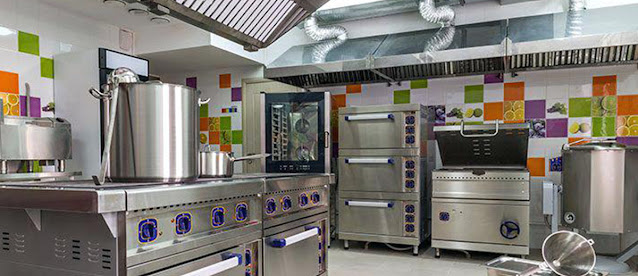Buying equipment without planning is a mistake.
Don't forget that the kitchen is the heart of your establishment, which is why
you need to be very careful in choosing the right equipment, in a layout that
supports production.
If You Don't Know Where To Start, Here Are 7 Tips
On How To Build Your Industrial Kitchen So You Don't Have Any Problems. After
All, After The Kitchen Is Ready, It Will Hardly Be Possible To Stop For A New
Renovation.
1 – DEFINE
THE BRANCH OF THE ESTABLISHMENT
An industrial kitchen can produce several types of
food, but each type needs specific equipment, spaces and flows, so defining the
branch of your establishment is the first thing to do. To prepare oriental
food, an industrial kitchen is very different from a kitchen for hamburgers or
a kitchen for a buffet, for example.
2 – HAVE THE
SERVICES AND THE MENU DEFINED
After defining the branch of the establishment, you
need to go deeper and define the types of services. Basic questions that must
be answered at this stage:
– Establishment operation: breakfast, lunch, happy
hour, dinner?
– Will the service be rent a Kitchen, self service, fast food, etc…?
– Will you use dishes, cutlery and dinnerware or
disposable cups?
– What's the menu?
The menu should be based on the defined services,
and the more detailed it is, the better to make a study of the layout of the
place.
What should be defined on the menu: types of dishes
(starters, side dishes, main courses, etc...), desserts and even types of
drinks (natural juice or pulp, for example, beer or draft beer, etc...)
3 – LOOK FOR
A PROFESSIONAL
Consulting an expert architect to design your commercial
kitchen in Sydney can save you a lot of headaches! The professional has
a broad view of this type of undertaking and the current legislation. It will
design a project according to your needs, maintaining circulation spaces,
installing in sequence those equipment that need to be close to each other and
separating the necessary areas so that there is no crossing of flows.
Furthermore, they are able to identify structural problems that could cause
great damage in the future.
With a project you can budget your investment and
forecast expenses, in addition to making a physical financial planning.
4 – CHOOSE
THE CORRECT EQUIPMENT
With the defined menu, list which equipment is
needed to produce those dishes. If more than one equipment has the same
function, analyze with the architect what is the most practical way to work. It
is also worth asking for help from the local chef and nutritionist.
Choosing the right equipment increases
productivity. And remember, don't just look for price, the quality of the
equipment is paramount, that poor quality equipment can interfere with the
operation of your establishment or even make the operation unfeasible.
Remember that there are gas and electric equipment,
to define which one to buy, I suggest analyzing the efficiency and consumption
of the two options.
5 –
SECTOR YOUR KITCHEN AND ENJOY EACH LITTLE PIECE
Its structure must function as an assembly line,
where each area is responsible for a step in the preparation of the dishes. The
kitchen has a flow and the layout must respect that. Think about future
expansions.
In smaller places, all details must be well thought
out in order to optimize the routine and ensure maximum use of spaces. Taking
advantage of all spaces does not mean leaving utensils and equipment out of
reach, we have to facilitate day-to-day operations.
And remember: there is no point in having a huge
demand if your kitchen is not capable of meeting it.
6 – PLAN
LIGHTING AND VENTILATION
Lighting and ventilation are very important! Give
preference to natural light and ventilation. Do not obstruct air passages.
Invest in a good exhaust system and hood so that it
absorbs grease particles and does not generate smoke. This system needs an
engineer's specific design.
If your space will have air conditioning, ask a
professional to calculate and indicate the best equipment for the area, as
stoves and ovens heat up the environment a lot and must be taken into account
when choosing the amount of BTUs
7 – KEEP AN
EYE ON THE LEGISLATION
There are a number of legal requirements for
setting up an industrial kitchen and putting it into operation. Take
legislation seriously, as it certifies that your establishment is operating
correctly. Look for the city hall in your city to get all licenses.
Read also: 7
tips for planning a kitchen on a budget
Posted by: John
Labunski



Comments
Post a Comment